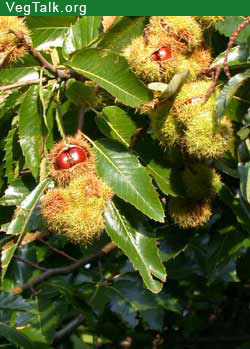
General info about Fruit
The Sweet Chestnut (Castanea sativa, family Fagaceae), also known as the Spanish Chestnut, is a species of chestnut native to southeastern Europe and Asia Minor. It is a medium-sized to large deciduous tree attaining a height of 20-35 m with a trunk often 2 m in diameter. The oblong-lanceolate, boldly toothed leaves are 16-28 cm long and 5-9 cm broad.
The flowers of both sexes are borne in 10-20 cm long, upright catkins, the male flowers in the upper part and female flowers in the lower part. They appear in late June to July, and by autumn, the female flowers develop into spiny cupules containing 3-7 brownish nuts that are shed during October.
The bark often has a net-shaped (retiform) pattern with deep furrows or fissures running spirally in both directions up the trunk.
The tree requires a mild climate and adequate moisture for good growth and a good nut harvest. It is sensitive to late spring and early autumn frosts, and is intolerant of lime. Under forest conditions it will tolerate moderate shade well.
Ways to prepare and serve the Fruit
Edible Parts: Seed.
Edible Uses: Coffee; Sweetener.
Seed - raw or cooked. A somewhat astringent taste raw, it improves considerably when cooked and is delicious baked with a floury texture and a flavour rather like sweet potatoes. The seed is rich in carbohydrates, it can be dried, then ground and used as a flour in breads, puddings, as a thickener in soups etc. The roasted seed can be used as a coffee substitute. A sugar can be extracted from the seed.
Health Benefits and Warnings of eating Fruit
Medicinal Uses
Antiinflammatory; Astringent; Bach; Expectorant.
Although more commonly thought of as a food crop, sweet chestnut leaves and bark are a good source of tannins and these have an astringent action useful in the treatment of bleeding, diarrhoea etc. The leaves and bark are anti-inflammatory, astringent, expectorant and tonic. They are harvested in June or July and can be used fresh or dried. An infusion has been used in the treatment of fevers and ague, but are mainly employed for their efficacy in treating convulsive coughs such as whooping cough and in other irritable conditions of the respiratory system. The leaves can also be used in the treatment of rheumatism, to ease lower back pains and to relieve stiff muscles and joints. A decoction is a useful gargle for treating sore throats. The plant is used in Bach flower remedies - the keywords for prescribing it are ‘Extreme mental anguish’, Hopelessness’ and ‘Despair’.
Other Uses
Basketry; Fuel; Hair; Starch; Tannin; Wood.
Tannin is obtained from the bark. The wood, leaves and seed husks also contain tannin. The husks contain 10 - 13% tannin. On a 10% moisture basis, the bark contains 6.8% tannin and the wood 13.4%. The meal of the seed has been used as a source of starch and also for whitening linen cloth[4]. A hair shampoo is made from the leaves and the skins of the fruits. It imparts a golden gleam to the hair. Wood - hard, strong, light. The young growing wood is very durable, though older wood becomes brittle and liable to crack. It is used for carpentry, turnery, props, basketry, fence posts etc. A very good fuel.
Classification
Scientific classification
Kingdom:Plantae
Division:Magnoliophyta
Class: Magnoliopsida
Order: Fagales
Family: Fagaceae
Genus: Castanea
Species:C. sativa
Binomial name
Castanea sativa
Recipes made mainly with this Fruit
The nuts are used by confectioners and are also eaten roasted. They are popular in Turkey, Portugal, France, Italy and particularly in Corsica. They may be roasted whole or ground to make flour. The Corsican variety of polenta (called pulenta) is made with sweet chestnut flour. A local variety of Corsican beer also uses chesnuts.